LD: Black Puddle
Third-Person Shooter, Mystery, Psychological, Thriller
Notes:
This was the first level design that I made seriously as a project rather than only practicing making blockouts, so the workflow was messy, but I learned a lot along the way.
This level design project was made streamlined as the game writing of Black Puddle was made, so the changes from the game writing immediately affect the workflow and the level design progress.
The final output of this project mainly focused on narrative, level design, environment art, and lighting aspects, so the programming aspect was not the priority.
There are live-view version of One Pager at the bottom of the page.
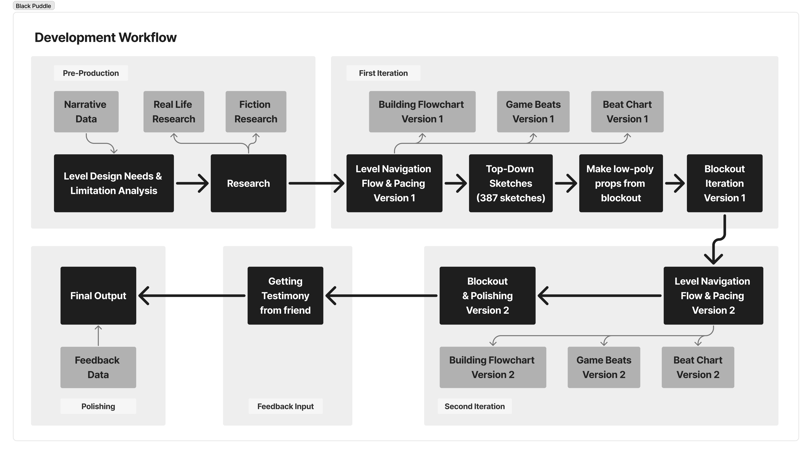



Needs & Limitations Analysis
The level design was built based on a story/narrative foundation rather than game mechanics. To make sure the level design has a proper working scope, I made an analysis that'll be used as the main guide throughout the development process.
Real-Life Research about Police Station & Building Renovation
Sources: YouTube videos, Pinterest pictures, websites from Google
Output: list of rooms, different types of buildings, layout references, real-life space dimension compared with adult humans.
(Some) Notes:
The room sizes and facilities that are available depend on the location of the place (rural, big city, etc.) and how important it is in the national police department hierarchy (headquarters, branch offices, etc.).
There is a clear dividing line between things that are related to normal civilians, detectives, police officers workplaces, and inmates. The path to the prison area is usually harder to access for normal people.
Private rooms are usually only occupied by higher-ranking officers, while the lower ranks are usually gathered in one big room based on their specialty.
Fiction Research about Police Station
Sources: Pinterest pictures
Output: layout, blockout, environment art, and overall vibe references.
(Some) Notes:
Furniture placement and size comparison with the room usually feel cramped, sometimes claustrophobic.
The workplaces, especially the detective desks, are messy, and there are a lot of card boxes used to store things.
A lot of police stations have classical/nostalgic feels like old cinema movies.
Research Phase
To maintain the originality of the project while keeping it relatable with other games in the market, there are two existing games that became the main inspiration: Silent Hill (muted ambience and environment) & Alan Wake I (dark multiverse with inner monologues). So, the level design must accommodate the heavy narrative while introducing the gameplay mechanics at a slow-paced tempo.
Game Inspirations
Besides accentuating the encounter with the abnormalities of Taksa Semesta—NPC transformed into Black Puddle, monsters reborn from the Black Puddle, and the transition effect when the earth collides with Taksa Semesta—the mission was designed to highlight the player's positive personality and how 'unfortunate' he is to experience those things even though he's a good man.
To build a connectivity but restricted feeling of a real police station, almost every room on the second floor is connected with the main hall. It unconsciously encourages the player to explore other areas 'while they're at it' & the player won't get lost.
The entire story happens in the present timeline, so there is no flashback scene or visual that shows something from the past. This way, the player will have firsthand experiences of all strange things related to Black Puddle and Taksa Semesta.
Act 1 was used to introduce the player to the character and the backstories, and the tension only grows slowly. But it marginally increases as soon as the conflict arises, when the player sees the eyewitness transform into a black puddle.
Game Beats Version 1
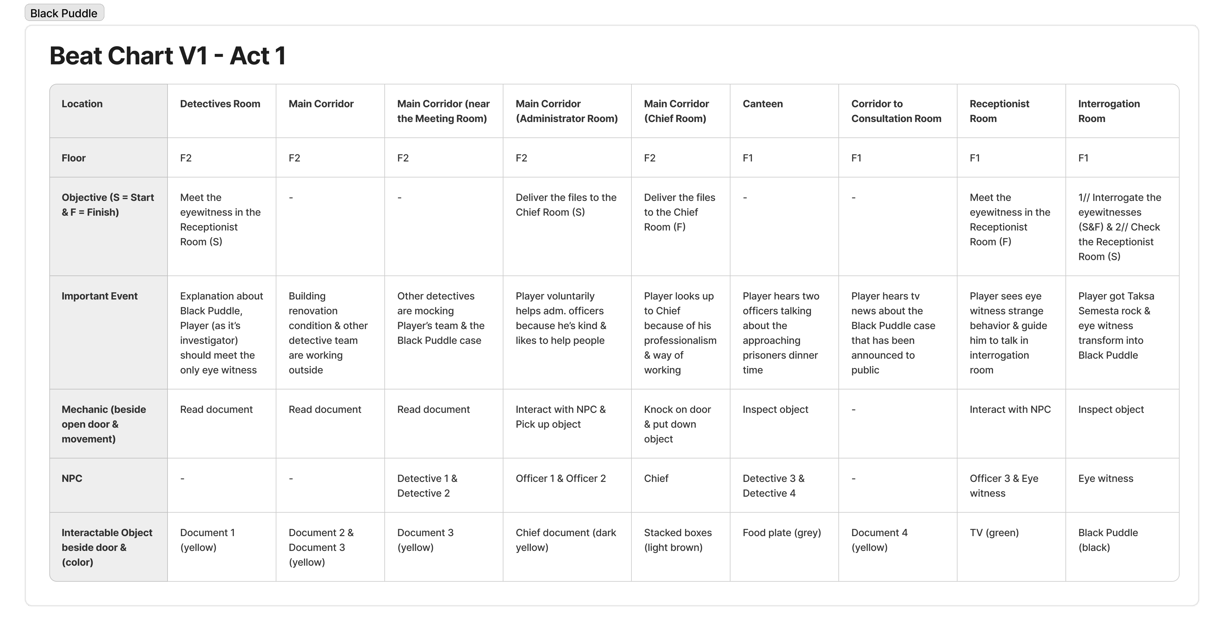

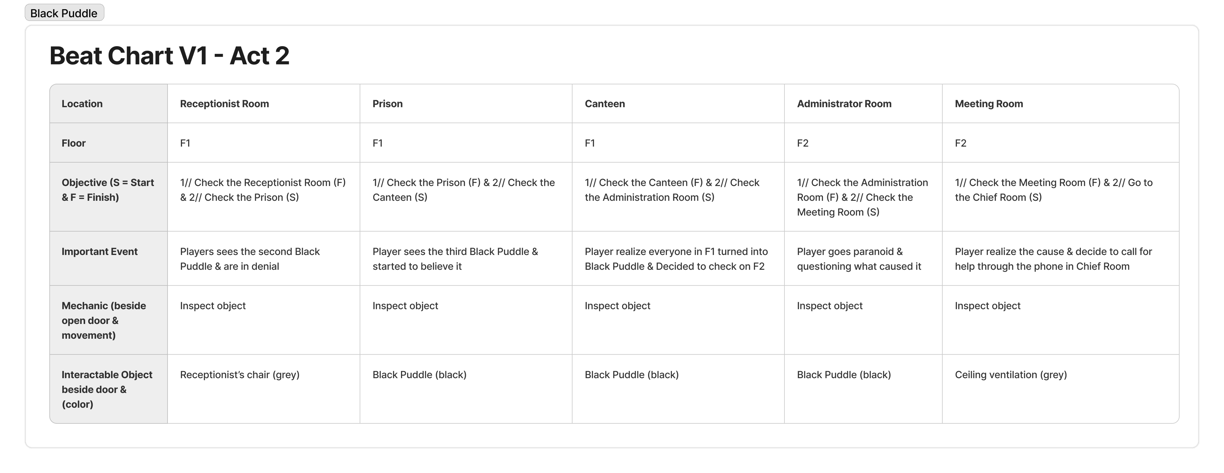


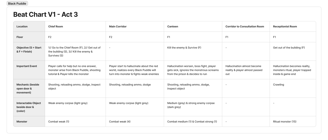

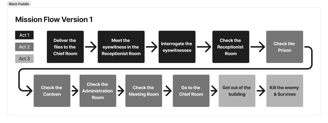

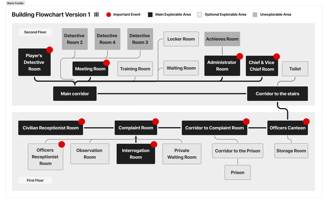
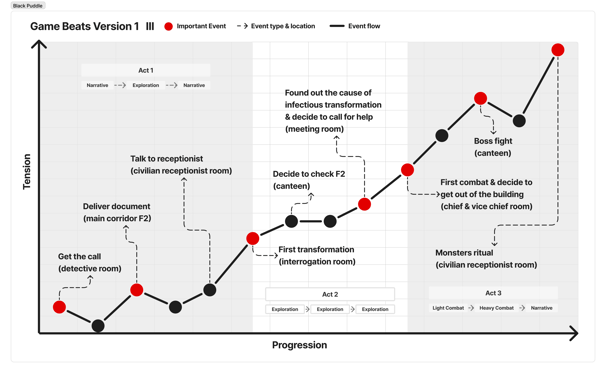

Beat Chart Version 1
Area Flowchart Version 1
Mission Flow Version 1
Top-Down Sketches
I did some manual sketches to grasp the overall shapes of the police station for the first floor and the second floor. To decide on the final sketches, I used the gradual elimination method with two criteria: feasibility and uniqueness if the sketches were made into a real-life building.
Pardon the unrelated scribbles on the sketches, as I made them in my collective gamedev sketchbook.
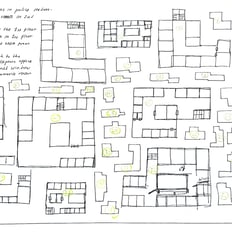
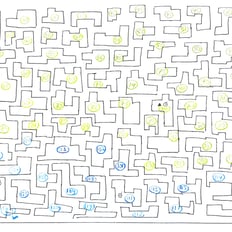
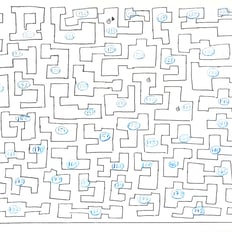
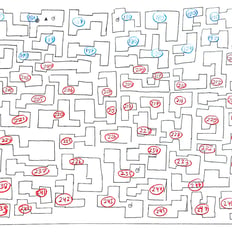
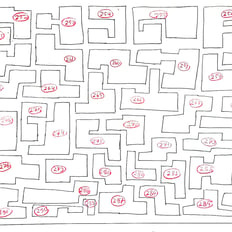

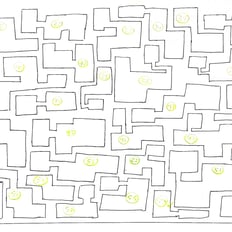
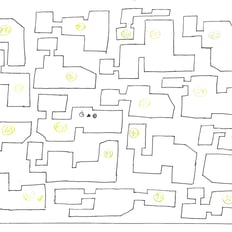
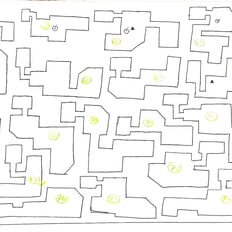
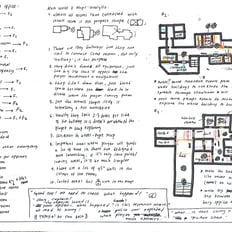
Low-Poly Props for Blockout
After deciding on the final sketches, I continue to make the building using ready-to-use assets from Unreal and Quixel. But in the process of it, I realized those assets were causing me to feel that everything was to be instantly perfect, which was completely opposite of what blockout is about.
Because of that, I made the low-poly version of the props in Blender and assigned plain world grid material in Unreal before using it in the real blockout iteration.


Blockout Iteration Version 1
This first blockout iteration was executing the final sketches using the low-poly assets. And it was a nightmare. The floor plan sizes are unrealistic, and it wasn’t fun to play. The sticky notes are the problems that I've found in this iteration.
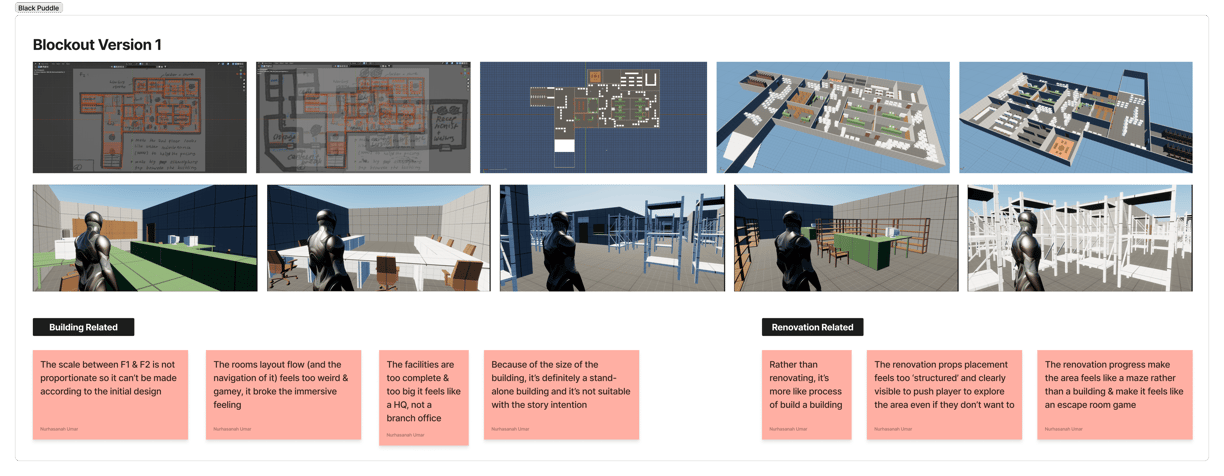

Showing the character's personality is important, but I realized it can be optimized in the scriptwriting process rather than directly put into the mission design. So, in this version, the mission was made to show more effects of the Black Puddle and Taksa Semesta to the normal world by leading the player to compare their experience when the world is still normal & when it got affected by Taksa Semesta.
After navigating through the first blockout, I realized the navigation flow was too centralized in the hall and caused it to feel boring, so it needs to be divided into smaller areas while optimizing the exploration experience.
This second flowchart solved that problem while making the layout memorable and easy to navigate. The accessible rooms also changed based on the asset's availability and the story progression.
In the game writing process, making a script based on the first story beat made me realize the story progression is way too fast and there is too much given information in one go, so it doesn't let the player deeply feel the psychological effects of Taksa Semesta.
And so, this second beat is focused on slowing down the story, reducing the amount of information given to the player, while intensifying the peculiarities of Taksa Semesta to give memorable psychological gameplay.
Mission Flow Version 2
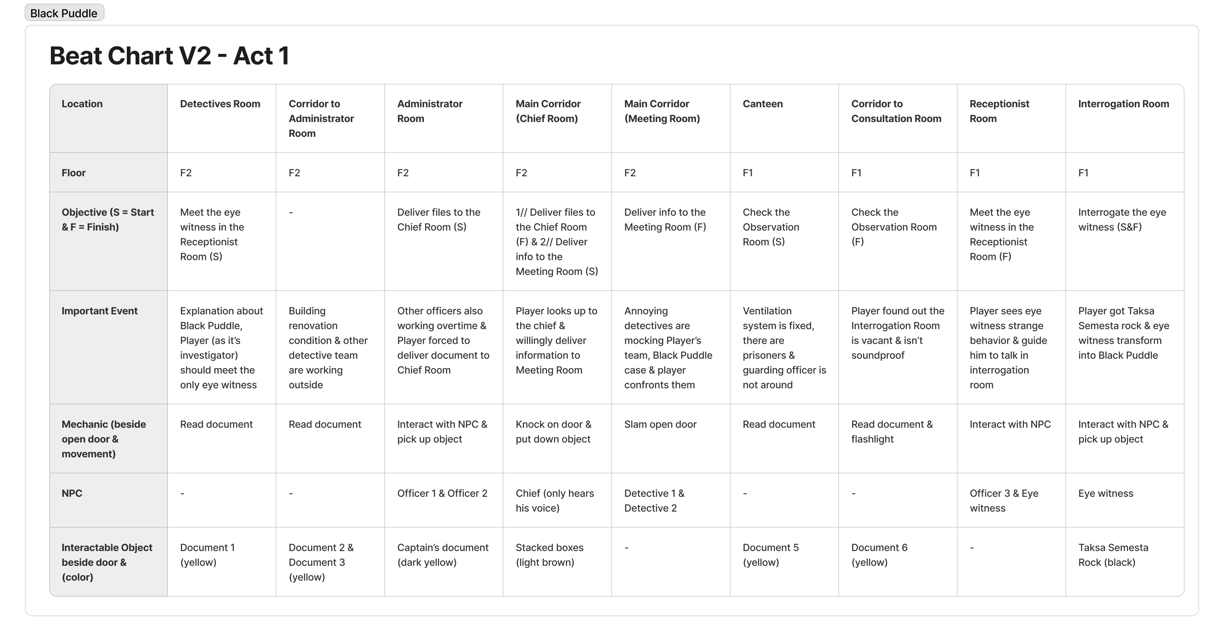

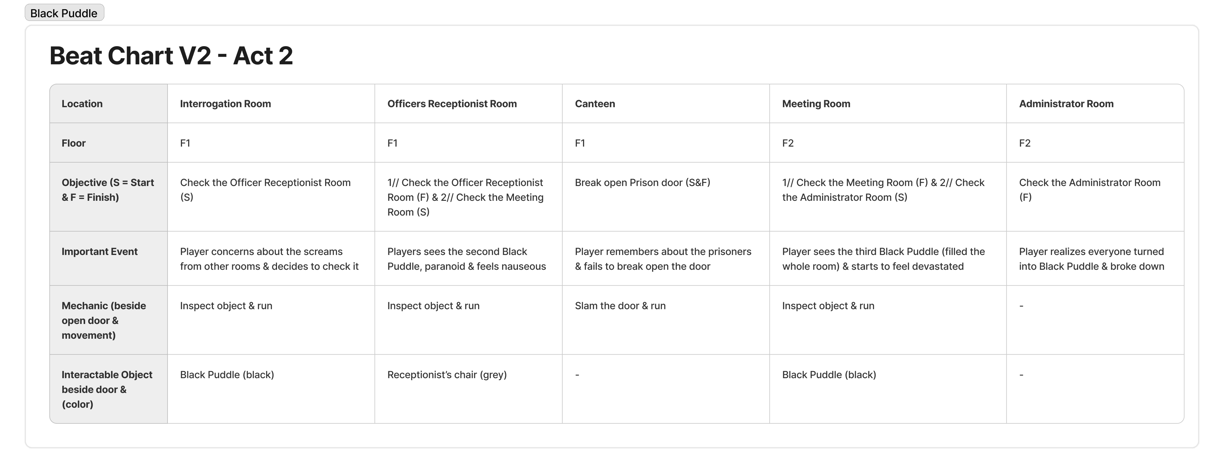

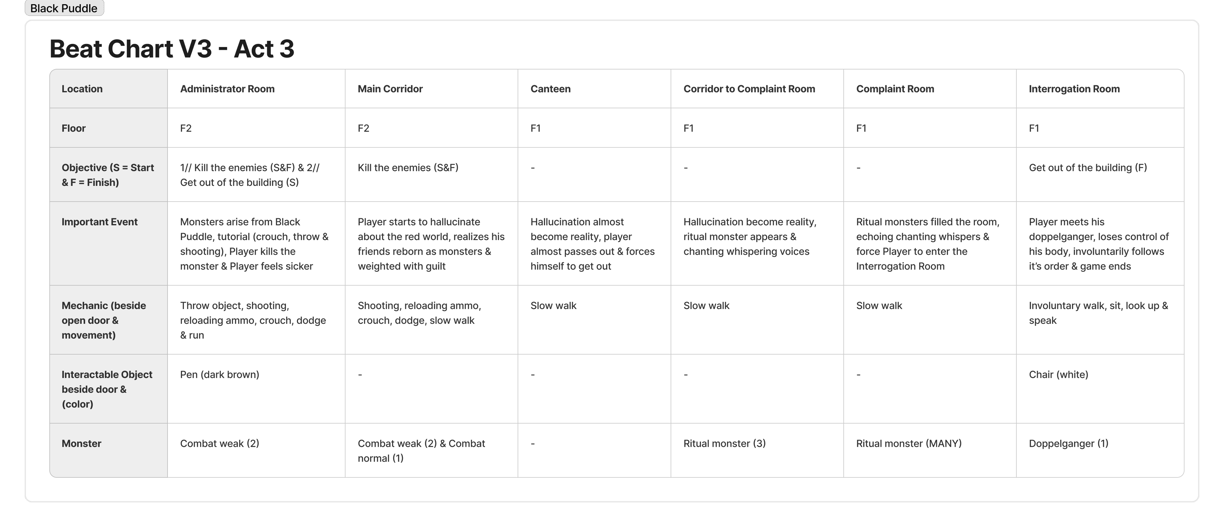



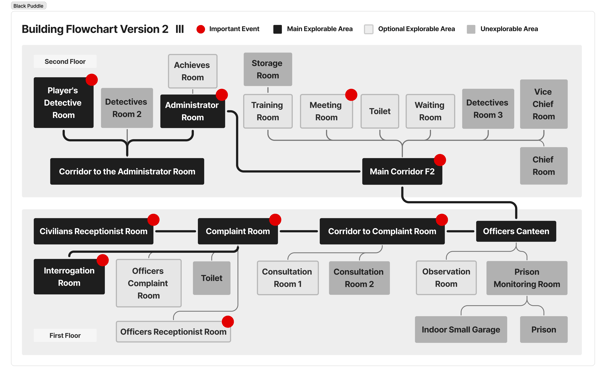

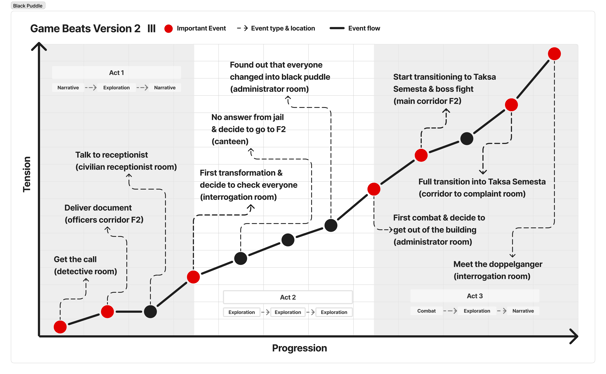

Game Beats Version 2
Area Flowchart Version 2
Beat Chart Version 2
Blockout Iteration Version 2
The main cause of how terrible the first blockout was was because I didn't do a playtest while making the level and solely focused on making it identical with the initial concept. This time, I self-playtested a lot throughout the blockout development. Beside that, I also solved the problems from the first blackout iteration on the green sticky notes.
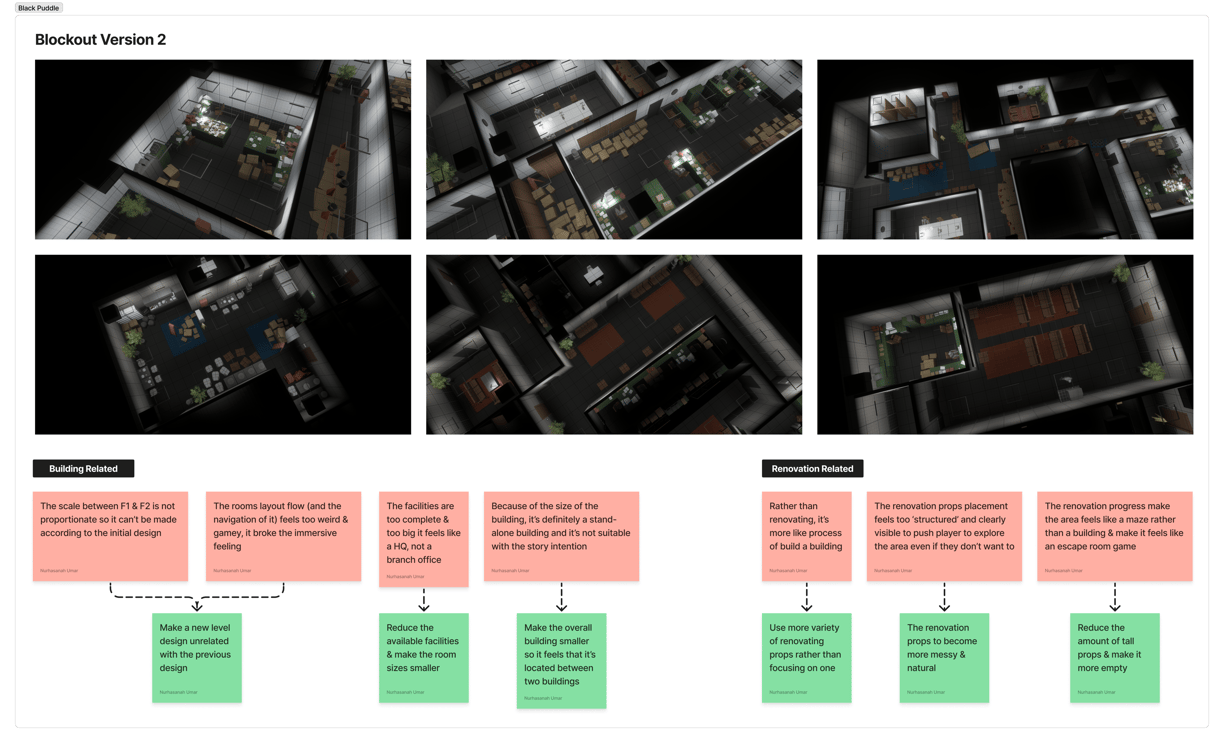

Getting Feedbacks From Friends
There are four respondents that I got the feedback from, and each of them has different specialty backgrounds and different kinds of feedback that I targeted. I did the interview one at a time and fixed the level based on feedback from the first respondent before continuing to the second respondent and so on, so there are 4 revisions in total before the final design was achieved. I also ask them to rank this project based on their area of expertise.


Final Blockout Breakdown
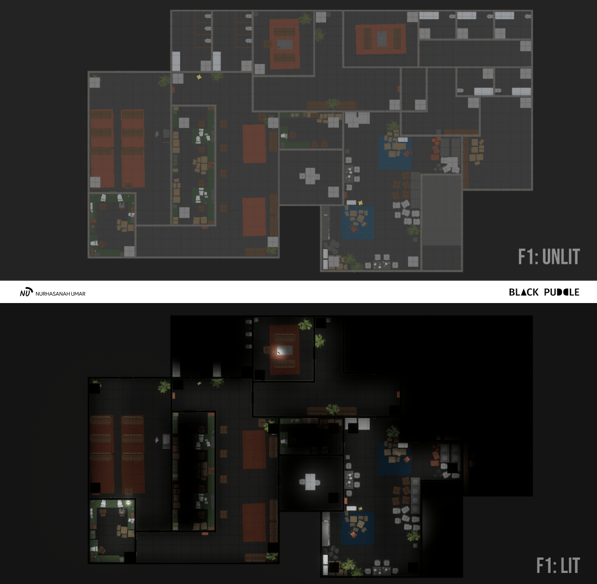


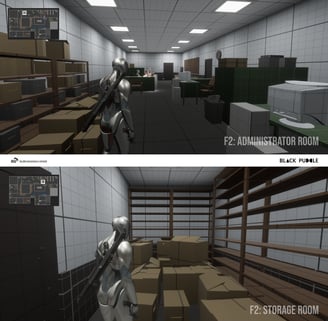
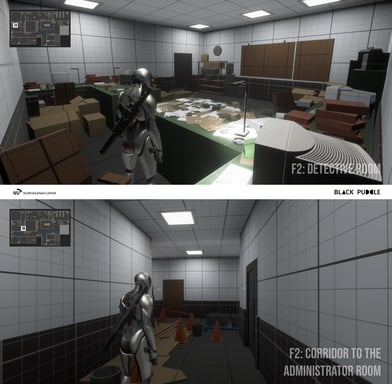

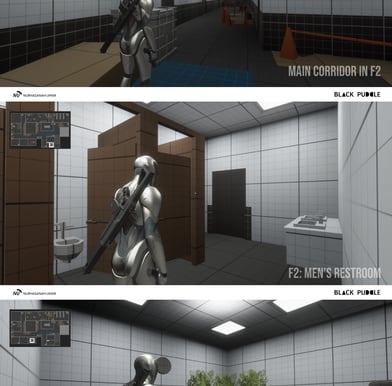



1A. Detective Room → Small room to give the impression the player is inside a small/medium-sized building & first look at how chaotic the working situation is.
1B. Corridor to The Administrator Room → Focuses on showing the whole building condition & introducing the ambience through visual storytelling.
2A. Administrator Room → The player interacts with NPCs for the first time, so every prop and light are aligned to guide the player to go to them.
2B. Storage Room → Additional explorable areas in F2 to deepen the building’s ambience.
3A. Main Corridor in F2 → For the first part of the game, it is purely used for connecting areas, so landmarks are added to easily navigate between places.
3B. Men's Restroom & Waiting Room → Additional explorable areas in F2 to deepen the building’s ambience.

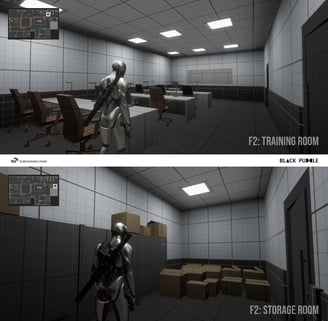


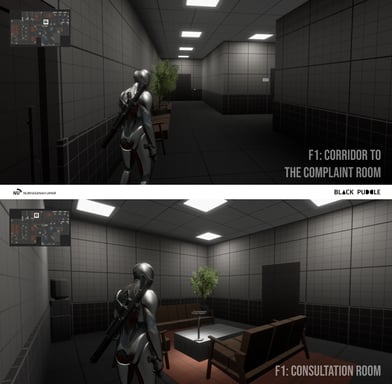

4A. Training Room → Another additional explorable area in F2 to show roughly how many officers are working here to deepen the backstory.
4B. Storage Room → Additional explorable areas in F2 to deepen the building’s ambience.
5A. Canteen → For this part of the game, it mainly used to show how the building was before it got renovated and how messy everything was in the officers related area.
5B. Observation Room → Giving breadcrumbs of how the interrogation room looks and causing anticipation for the player to interrogate the witness.
6A. Corridor to The Complaint Room → Transitioning the area between the officers and the civilians so the props are kept to a bare minimum to avoid distraction.
6B. Consultation Room → Additional exploration area in F1 to deepen the building ambience & give visual information of how they treat unimportant people.



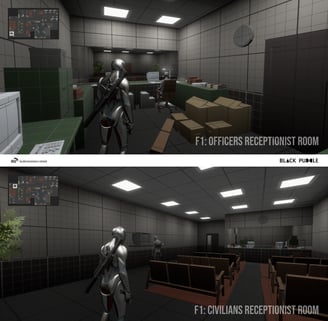


7A. Complaint Room → It’s the main interaction area between civilians and officers, so the room is big to make it multipurpose: waiting room, consultation room, & a corridor.
7B. Officers Complaint Room → Additional exploration area in F1 shows the working condition of officers & the civilian reports incensement.
7C. Interrogation Room → Additional exploration area in F1 to give a glimpse of how it’ll be to use the room.
8A. Officers Receptionist Room → This room let the player see the eyewitness from afar, setting the tension & anticipation to interact with the eyewitness.
8B. Civilians Receptionist Room → It’s the place where the player meets with the eyewitness, so the room is purposely designed to look ordinary to emphasize the NPC.
9A. Interrogation Room → show the Black Puddle & indicate people transforming into it.
9B. Officers Receptionist Room → show the Black Puddle & indicate people transforming into it.
9C. Complaint Room → 9D. Canteen → The player tries to break open the door but fails to do so.
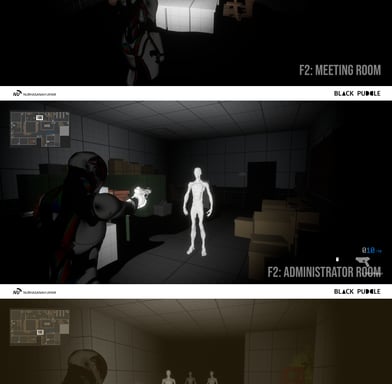


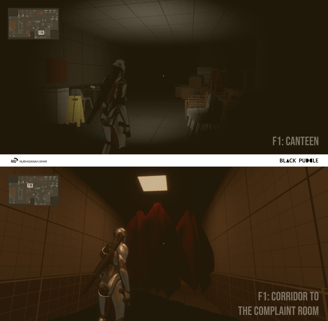
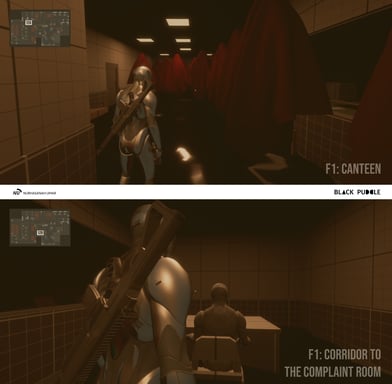

10A. Meeting Room → Black Puddle almost filled the entire area to show how big the puddle can be & increase the progression tension.
10B. Administrator Room → The first transformation into a monster, combat area & teaching the combat mechanics.
10C. Main Corridor in F2 → Main place for combat, high-paced gameplay, desperation, & first experiences of hallucination for the player.
11A. Canteen → Place where the player heavily experiences the hallucination & ambience changes even though the surroundings stay the same.
11B. Corridor to The Complaint Room → Place where the hallucination becomes the reality & the introduction of another monster (Peniru).
12A. Complaint Room → This room now focuses on showing the eeriness and changes the Peniru can make; even the ordinary place can feel scary.
12B. Interrogation Room → Final area where the player meets his doppelganger (Peniru), the most strange gameplay, peak suspense, thriller, confusion & cautious feeling.
Layout of F1
Layout of F2
One Pager

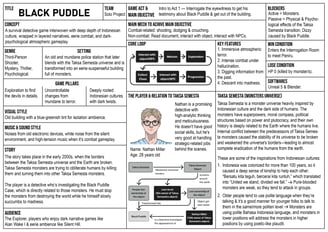
Things I’ve Learned
If you focus on using ready-to-use assets from the internet, it's mandatory to understand their potential and limitations. This way, the level design can be adapted early based on the narrative and asset availability, so the environment art will follow them and not the other way around.
Asset availability will decide what kind of area that we can and cannot work on. Use this data right from the start to focus on research in the area that can be made and focus on them. It leads to a more effective, efficient, and trackable workflow that can be referenced for other divisions (game writing, environment art, sound design, etc.).
The purpose of blockout is to do rapid and repeated testing to achieve the desired gameplay experience, so using final 3D assets in this phase will be visually distracting. To redirect the focus back to the 'experience,' immediately create the low-poly version of the ready-to-use assets with simple grid materials and use it for the blockout.
Making top-down sketches is good for brainstorming, especially in the early development phase. But these can't 100% guarantee the sizes and shapes are suitable in the blockout phase. Focus on making the blockout digitally and do more playtests to make sure the layout works.
Input from people is crucial to improve the project—they see things from different perspectives, and it's more credible when they're professionally capable in certain aspects. Analyze the input, deeply consider it, and implement the feedback that is feasible and will improve the project.
Level design is all about making and improving gameplay experience, so changes will constantly happen. Don't get too attached to anything—ideas, concepts, layouts, etc.—so we can process everything logically and improve the gameplay experience so it'll become objectively better.
